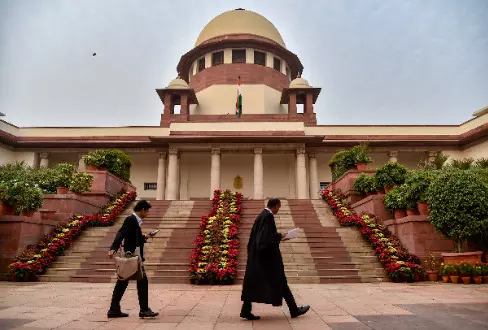SC flags career stagnation in judiciary, begins hearing to frame nationwide seniority norms

New Delhi: Expressing concern over the slow and uneven career progression of entry-level judicial officers across India, the Supreme Court on Tuesday began the hearing on framing uniform, nationwide criteria for determining seniority in the Higher Judicial Service (HJS) cadre.
A five-judge Constitution bench headed by Chief Justice B R Gavai took note of the situation that “in most of the states, judicial officers recruited as Civil Judge (CJ) often do not reach the level of Principal District Judge (PDJ), leave aside reaching the position of a High Court Judge. This has resulted in many bright young lawyers being dissuaded from joining the service at the level of CJ”.
On October 14, the bench, also comprising justices Surya Kant, Vikram Nath, K Vinod Chandran and Joymalya Bagchi, framed the question which reads: “What should be the criteria for determining seniority in the cadre of Higher Judicial Services”.
The bench also clarified that while hearing the main issue, it can also consider “other ancillary or related issues”.
The bench is also examining whether a separate quota of District Judge (DJ) posts should be earmarked for officers who entered the judicial service at the lowest rung as Civil Judges (Junior Division), in order to ensure fairer career advancement opportunities.
Senior advocate Sidharth Bhatnagar, who is assisting the bench as an amicus curiae, advanced the submissions and highlighted that promotions across most states were “driven more by seniority than by merit”, owing largely to the way Annual Confidential Reports (ACRs) are evaluated.
“Almost everyone has ACRs marked as ‘Good’ or ‘Very Good,’ which means seniority becomes the de facto determining factor,” he said.
He said that the existing “roster points” system disproportionately disadvantages promotee judges, many of whom have over two decades of judicial experience but are unable to enter the zone of consideration for elevation as Principal District Judges or High Court Judges.
“Promotee judges, being older, often retire before reaching the next promotional stage. Consequently, the top of the cadre is usually occupied by direct recruits, who are younger and hence remain eligible for longer,” he said.
He said that most high courts consider three times more judges for promotion as district judges. He suggested that for 30 considerations, 15 should be from the promotee judges and 15 from direct recruits.
“Your suggestion will, in fact, create a cadre within a cadre. If there are 10 candidates eligible for supertime or selection grade, it would be 5 from promotees and 5 direct recruits. So what will happen is (that) at the district judge, entry level, it is a common cadre. If the second suggestion is adopted, then we are creating a cadre within a cadre,” Justice Bagchi said.
Justice Surya Kant questioned whether the current framework provided any incentive for Civil Judges to strive for merit-based promotions.
“The 25 per cent departmental quota is supposed to reward merit. But if it is filled only on seniority, what incentive is left to work hard” the judge asked.
Justice Bagchi and Justice Chandran expressed reservations about certain proposals advanced by the amicus that could create “a cadre within a cadre”.
The amicus curiae suggested that a 1:1 ratio between promotees and direct recruits be maintained even at higher grades to ensure proportional representation.
Justice Bagchi noted that such a move “would stratify an otherwise common cadre”, and that any such modification would need to be uniform and equitable across states.
Citing the Justice Shetty Commission Report, the amicus presented comparative data highlighting stark age differences between promotees and direct recruits.
“In Andhra Pradesh, the average age of a promotee is 48, while direct recruits are around 39. In Assam, it is 51 versus 38; in Bihar, 54 versus 41,” he said.
He said that after the Supreme Court’s decision requiring a minimum of three years’ practice before joining as a Civil Judge, the entry age for new recruits has further increased, worsening career stagnation.
Senior advocate Vibha Datta Makhija, appearing for officers who entered the District Judge cadre through the Limited Departmental Competitive Examination (LDCE), described her clients as “the grain sandwiched between two stones”.
“We are treated as part of the promotee group and are therefore deprived of the benefits intended for our category,” she said, urging the court to ensure that LDCE officers are recognised as a distinct stream within the promotional structure.
Justice Surya Kant cautioned that excessive emphasis on competitive examinations could create a “crisis” at the junior division level, as younger officers might focus more on promotions than on case adjudication.
“If promotions hinge entirely on competitive exams, judicial officers may neglect their regular duties in pursuit of future advancement,” the amicus said while agreeing to the observation of the judge.
One of the intervenors said that in the Bombay High Court, only district judges, who were direct recruits, were considered for elevation as HC judges since 2020.
The promotee district judges retire before being considered for elevation to the high court, he added.
The hearing would resume on Wednesday.



